In Texas alone you'd have to kill almost 2M pigs per year to contain “the worst invasive species we’ll ever see.”
For millions of years, as pigs snorted and snuffed their way across the planet, evolving and learning to dodge gray wolves and tigers and coyotes and alligators, they were almost assuredly safe from any potential threats from the sky.
Then they arrived in Texas, where in addition to the rare predatory large mammal, a wild pig today might be forced to evade, for example, a cascade of 5.56-caliber bullets fired from a hundred-odd feet above by an AR‑15 semiautomatic rifle in the hands of some adventurous tourist from Pennsylvania or Mexico or Australia. Unfortunately for said pig, evolution has not yet blessed him with the neck flexibility needed to look up. Thus, he hears only the thundering roar of a helicopter before it all goes down. He’ll run around, searing bursts piercing the ground around him, until inevitably he’s struck, usually a number of times, left to die in a scrub of brush or a field of cotton or a row of cornstalks. The chopper will fly away, only to move on to some other unsuspecting, ground-focused pig.
A lot of people in Texas would say this does not happen enough.
***
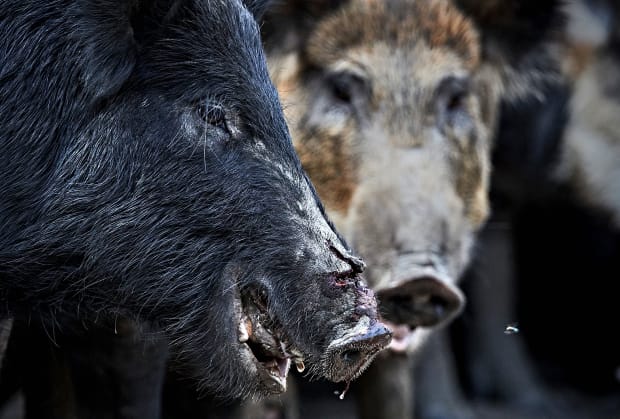
This is not quite hunting. At least not so far as the sport is generally conceived. It’s more like hunting’s souped-up, ecologically inspired cousin—an intensification many see as necessary in taming a chaos for which more traditional hunting is to blame.
Wild pigs—a catchall term, synonymous with “feral hogs” or “razorbacks,” that includes escaped domesticated swine and their descendants; wild boars; and crossbreeds between the two—are not typical pigs, or even typical wild animals. Compared with the pigs found on farms and in children’s books, they have thicker hides, leaner builds, longer and darker hair, and sometimes tusks. An average wild pig weighs around 150 pounds, but it’s not unusual to see triple that. As species go, they’re aggressively invasive and, crucially, prodigious, able to breed at less than 12 months old, producing an average of two five-to-six-pig litters every two years. World over, the wild pig population is estimated between seven and eight million, of which some 2.6 million could reasonably consider themselves Texans.
Which wouldn’t be such a problem except that wild pigs don’t become a part of their environment so much as they rampage through it. They have incredible senses of smell, aggressively omnivorous appetites and athletic capabilities that leave them nearly impossible to control. They can scale five-feet-high fences or burrow through almost anything they can get their noses under. They wreck barriers, freeing livestock and other animals, to whom they may pass on any of dozens of diseases and parasites, or whose young they may settle on as meals. Feral hogs can disrupt entire ecosystems by competing with local wildlife for vegetation or by rooting out seedlings. Although they typically flee from and rarely bother humans (the
2019 death of a Texas woman in a hog attack was an outlier; Mets outfielder Yoenis Céspedes’s recent hog-related injury was tied to his trapping a pig), they still wreak havoc on any number of man’s pursuits, destroying historical sites, ripping up golf courses, contaminating water supplies. They decimate crops, devouring fields of corn, sugarcane, wheat, oats, melons, pumpkins and whatever else they find appetizing, typically leaving farmland too ravaged to reharvest. It’s not unheard of for a farmer to take a $70,000 hit overnight. In fact, the federal estimate of the total annual damage done by wild pigs is $1.5 billion. One USDA researcher has called them “the worst invasive species we’ll ever see.”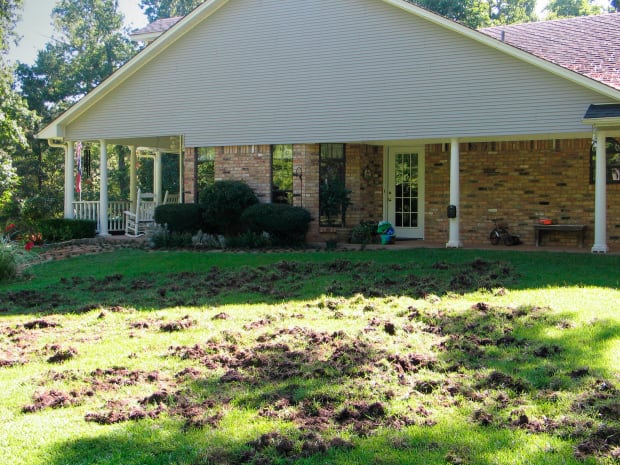
All of which is to say: When one Arkansan last summer went viral by jumping into a Twitter debate about assault rifles and asking, essentially, But what do I do about feral hogs in my yard? he was posing a somewhat valid question, however ridiculous it may have seemed to the countless appalled commenters who jumped into the fray. Someday, though, they’ll understand, as this invasion is spreading. Wild pigs can live just about anywhere—in swamps and forests and brush, in climes warm and cold. Three decades ago they inhabited 20 U.S. states; that number has since doubled. And where they already were, now there are even more. Since the 1960s, California’s wild pig population, for example, has swelled from roughly 100 to some 300,000.
Texas, though, is something else: Feral hogs can be found in 253 of 254 counties. And given their prolific breeding, at least two-thirds of that population—upward of 1.7 million pigs—must be killed each year simply to keep the count level. Current efforts, however, are estimated to accomplish less than half of that culling.
“There are probably a dozen states, including Texas,” says Billy Higgin-botham, professor emeritus of Wildlife and Fisheries at Texas A&M, where “eradication is not even on the table.” The more realistic goal is merely a greater measure of control.
But control doesn’t spark the motivational appeal of eradication, and eradication doesn’t hold the gravitational allure of hunting. So ingenuity equal parts entrepreneurial and Texan has birthed an industry to limit this porcine destruction. For as little as $1,000 (and as much as $12,000, with add-ons like lodging and unlimited ammo) a hunter or wannabe hunter can book a helicopter ride for the purpose of gunning down wild pigs, typically with an assault rifle. “The customer wants to go hunting; we want to go eradicating,” says Barrett Blume, the owner of one such outfit. “We make this blend of compromise and we do both.” The name of his operation: Last Shadow, referring to the silhouette cast by a chopper—the final thing a pig in the crosshairs will see.
Wild pigs, by all accounts, make entertaining quarry for these sportsmen. They’re smart, elusive and faster than you think—up to 30 mph at a sprint. And that very appeal is, essentially, the root of the whole problem. America’s love of pigs as sport-hunting fodder has sowed a situation it can’t shoot its way out of. And might not want to.
“If they were not fun to hunt, we would not be in the shape we’re in,” says Higginbotham, a beard’s worth of mustache framing his mouth on three sides. “And I term it to be: We’re in a war.”
***
Go back a few decades, as recently as the early 1980s, and you’re unlikely to see any signs of this man-versus-pig conflict in the U.S. In fact, until Europeans began showing up a few centuries earlier, there were no pigs anywhere on the continent. Christopher Columbus brought eight of them to what is now Cuba on his second trans-Atlantic voyage, in 1493. Almost 45 years later the Spanish explorer Hernando de Soto scooped up a dozen members of that Cuban lineage for his trip into North America, beginning near modern-day Tampa Bay. In both cases the idea was the same: Pigs made a perfect mobile food source, and they could repopulate their stock while foraging for themselves. By the time de Soto died, three years into his journey, even after scores of pigs had escaped or were butchered or traded with locals, the pig population in his exploration party had ballooned beyond 700.
With more Europeans came more pigs, sometimes by the hundreds. It wasn’t until the late 19th century, though, that the real trouble started. That’s when America’s burgeoning ultrawealthy began importing wild boars from Europe to stock hunting preserves as far north as New Hampshire and New York’s Adirondack Mountains. Many of the animals in the hunting grounds escaped and seeded wild populations around the region, often crossbreeding with feral domesticated pigs, spreading farther and farther out. At the same time, existing populations to the south were wreaking increasing havoc. After famed landscape architect Frederick Law Olmsted visited Texas in the mid-1800s and saw pigs raid his camp nightly, he wrote that he was “annoyed by hogs beyond all description.”
In a way, the story of wild pigs paralleled that of their newfound home: a product of European colonialism come to pillage the continent, expanding ad infinitum.
These two stories began to intersect in a concerning way in the late 1980s, when the wild pig population started to soar, from some two million across the U.S. to nearly four times that now. It was an explosion long coming. Across the Southeast, as well as in California, game departments had been stocking pigs, promoting them as a huntable big-game resource. Elsewhere, residents had started to leave feed for wildlife, like white-tailed deer and quail, in order to foster populations for hunting—which meant unwittingly supporting local pigs, too.
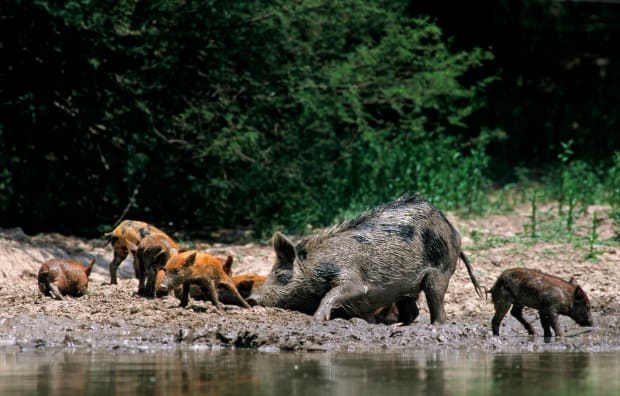
The biggest contributors to the problem, though, says Higginbotham, were scofflaw hunters. The more they enjoyed hunting wild pigs, the more places they sought to do so. That meant trapping loose swine where they already lived and releasing them where they did not, to seed new populations. Suddenly, the people most interested in killing wild pigs were expanding the animals’ territory even faster than the pigs could themselves. Which is why modern distribution maps show isolated clusters in places like Illinois, Michigan, North Dakota and Washington. Enthusiastic as those hunters may have been, the relocated pigs bred faster than they could be killed off. Soon, the very things that humans had for so long liked about the animals rendered them an ungovernable nightmare. “It’s like that old saying: Don’t mess with Mother Nature,” says Jack Mayer, a biologist at Savannah River National Laboratory in Aiken, S.C. “It’s something we did to ourselves.”
Nowhere did nature retaliate worse, though, than in Texas. Some farmers in the state have taken so many hits to high-value harvests, such as peanuts and corn, that they’ve shifted to lower-valued crops, like cotton, which pigs find less attractive. There are endangered toads whose breeding grounds are regularly ruined and sea turtles on the Gulf Coast whose eggs are gobbled up like popcorn. Cars routinely collide with massive hogs on Highway 130, outside Austin. More than 100 springs in the state are contaminated with swine-related E. coli. In 2014, one church outside Houston was so worried about its annual pumpkin sale that it enlisted armed guards to stand watch over the patch at night.
“In 1982 the USDA killed 86 feral hogs” in Texas, says Mike Bodenchuk, a San Antonio–based wildlife biologist. “Thirty years later we’re killing 30,000. We look at other states—Kansas, Missouri—and say, ‘You guys are where we were 30 years ago. You don’t wanna be where we are today.’ ”
How to prevent that future? Hog traps with built-in cameras controlled by smartphone can cost more than $6,000. In Texas the agricultural department tried to fast-track a warfarin-based poison, but there were too many concerns about killing other animals who might eat the bait—or the deceased hog.
Support for any large-scale effort is hard to garner. Pigs present an off-beat problem that many citizens have been slow to take seriously. And Texas, in many ways still a republic unto itself, presents its own unique challenges. States like Kansas and Missouri have banned hunting wild pigs on public lands in a well-received (if counterintuitive) attempt to stamp out sport hunters’ motivations for releasing hogs within their borders. But some 95% of the Lone Star State’s 268,000 square miles are privately owned—and fiercely so—meaning that any attempt at coordination will have to involve scores of landowners. A systematic government response is next to impossible.
Necessity, however, is the mother of invention. And Texas is Texas. So there had to be another, bigger way.
***
Sid Miller is one of those private landowners; he farms wheat and hay on about 1,200 acres southwest of Dallas. He’s also the Stetson-wearing commissioner of the Texas Department of Agriculture, and before that he served for 12 years in the state House of Representatives. It was in the latter capacity, in 2011, that he finally grew fed up with the wild pigs that so often munched on his crops. He had tried trapping and gunned down a few hogs himself, but he thought the conditions existed for a more creative approach. So, “I used some cowboy logic,” he says.
What Miller concocted—a very Texan blend of deregulation, private enterprise and arms -escalation—became known, to his enduring amusement, as the “pork chopper” bill. His legislation (which passed 141–1) enabled ranchers and aircraft operators to charge for helicopter seats with the express purpose of hunting wild pigs, which in Texas requires no license. Naturally, this bill’s passage drew more attention than usual. “There was some of, you know, Look what Bubba’s doing now,” says Miller. “But people soon realized how serious a problem it was.”
Many also recognized a business opportunity. Among them: Blume, with his chinstrap beard and passing resemblance to Baker Mayfield. After a few stabs at college, he says, he was “fumbling around at life,” working at a military-training company and failing to catch on with the French Foreign Legion. Eventually he started helping an acquaintance book aerial hog hunts, and in late 2013 he got to know a former Air Force mechanic, Richard Potts, who owned a four-seat helicopter. Blume brought the bushy-goateed Potts into the fold, and that was the start of Last Shadow, which today zips clients around a 300,000-acre zone surrounding its base in Temple, smack between Austin and Dallas
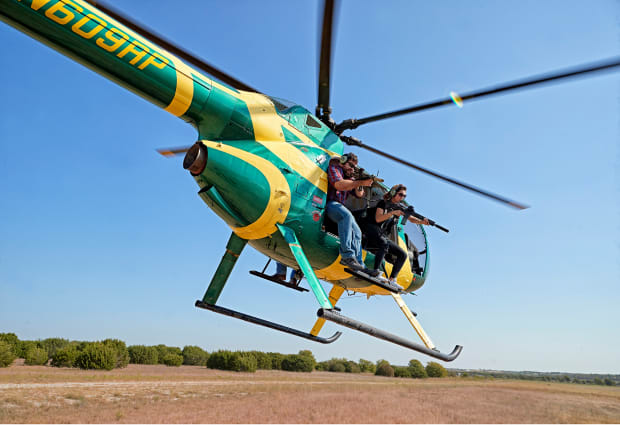
More than 100 businesses—with equally playful names, like SwineTime and HeliBacon—are currently permitted to offer such trips (though for many, hunting is primarily a sporadic side venture). These outfits typically cut deals with the landowners whose properties they patrol, some paying for the right to shoot on said soil, and they face state and FAA restrictions regarding where clients can shoot, relative to roads and houses. In the case of Last Shadow, roughly 75% of clients come from outside Texas—some hunters, some thrill seekers, some curious visitors looking for a uniquely local adventure.
Whoever that is, no one’s taking home a freezer’s worth of pork loins and baby back ribs. In the time it takes to land a helicopter, other wildlife are typically already feasting on any gunned-down pigs. (Besides, the USDA requires predeath inspection in order for meat to be sold or donated.) Instead, Blume sells customers on the experience, as well as the benefit to the local ecosystem. “We get laughed out of a lot of places,” he says. “A lot of hunting groups, research groups, they don’t consider us real. And I get it. The perception is, Hold my beer; here’s your rifle. Bunch of Texans riding around in helicopters, shooting guns. So there’s that stigma.” (Blume is, in fact, pretty popular locally. “I get calls all the time,” says one area crop insurer. “ ‘What’s the helicopter guy’s number?’ ”)
The blowback, though, is real. Animal-rights groups take issue with how many wild pigs are maimed in such hunts, not killed. (“This seems like it’s potentially not a part of a controlled, precise management network,” says the Humane Society’s John Griffin.) Some experts also contend that the chasing and hunting of pigs, on land or by air, will only drive populations back and forth between properties—or, worse, split sounders (as a group of pigs is called) into smaller units that may settle in new areas.
Mayer, the South Carolina biologist, believes that real eradication would require eliminating all financial incentive for wild pigs to persist, and as things stand, there’s a mini-economy built around their existence: the chopper companies and night-hunting outfits, the suppliers of specialized hog-hunting equipment, the meat purveyors who buy and sell trapped pigs, the restaurants that serve wild pig dishes, the land owners who lease their land for hunts. . . . “That’s a lot of revenue that’s gonna disappear,” Mayer says. “You get money involved, it just complicates everything.”
At the core of all this is the question of how impactful hunting (even the relatively efficient aerial variety) can be. Blume says that Last Shadow kills as many as 1,200 pigs in a quarter. But even if you extrapolate that number across the entire industry, in all of Texas—say, 50 companies over four quarters, killing 240,000 pigs a year—it’s nothing compared with the 1.8 million that would need to be removed annually just to cap the state’s population growth. “Hunting alone won’t get this done,” says Bodenchuk, the Texas-based USDA biologist. “They want to turn a literal sow’s ear into an actual purse, and it’s not working.”
Not that Texas would benefit from putting an end to pig hunting altogether, as Missouri and Tennessee have done. “We’ve got such a large population now,” says Higginbotham, “that it wouldn’t do any good to say we’re gonna stop.”
In the meantime, some suggest that the hunt itself is getting harder. When bookings are slow at Last Shadow, Blume and Potts will often fly maintenance trips, as a service to landowners. And they’ve noticed that the pigs—who over recent decades have become increasingly nocturnal, to avoid human hunters—are adapting to their pursuit, sometimes sending one pig into the open as a diversion while others head elsewhere. “No matter what,” Blume says, “there’s always gonna be something they’re scheming.” (Potts likes to joke that the pigs are collecting brass out in the field, planning to someday retaliate.)
So, end pig hunting? Blume would sooner double down. He wants greater coordination between the helicopter companies, maybe even state subsidization to fill the periods when customers dry up. He wants to combat the perception that he and his ilk are a bunch of yahoos. He wants the general public to understand the environmental and economic impact of wild pigs, to grasp the science of eradication. And he wants to rent a satellite—to see even better, from even higher, where the pigs are and where they’re headed.
***
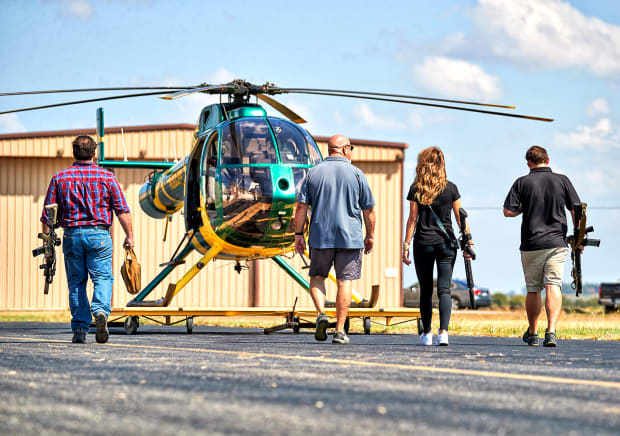
Under a vivid July sun, Potts fires up the Last Shadow chopper, christened Clarice (as in “Silence of the Hams,” Potts jokes), for a demo run over central Texas. The vehicle glides over above-ground pools and unbothered steer and backyards the size of par‑4s, eventually arriving at acres and acres of open field. Last Shadow’s safety officer, an amiable skydiving devotee named Ashley Lewis, is strapped in the back with a (safetied) assault rifle across her lap. In her four months on the job, this will be her first time actually shooting at pigs from the air—if they find any. Of that there’s no guarantee. Earlier, she rode for an hour with a quartet of Long Island teens and didn’t see a single hog.
Potts cruises at 400 feet for a fruitless 15 minutes, the possibility of another shutout looming. “There are pigs out here, I know it,” he says into a helmet headset. “They probably see us.” He’s fond of saying that the minute you claim to know what a pig will do is the minute said pig has made a liar of you.
Clarice is sailing over fields of cotton and corn, most of the rows marred by empty patches where pigs rooted out seeds, when Potts slows the chopper and announces, “Here we go.” A dozen or so swine scurry out from the brush and Potts descends below 30 feet. “Go ahead, Ashley—bang-bang-bang,” he says. And she does. Bang-bang-bang. A large gray hog in the back of the group, maybe 150 pounds, drops. More bursts of fire, and a few more pigs fall. The rest get away.
“They’re laughing at me,” Lewis says.
“They’re running from you,” Potts tells her.
“Yeah. Running and laughing.”
Eventually a straggler darts out from a bush, into some tall grass, knocking the haulms about as it sprints, and Lewis fires until it stops. Potts lowers the helicopter, and the air parts the grass where the pig is lying. It raises its head, then collapses into stillness.
In the end, after half an hour or so, Lewis’s tally will have reached six for the day. The same number born in one litter, to one pig, somewhere among the millions not seen.
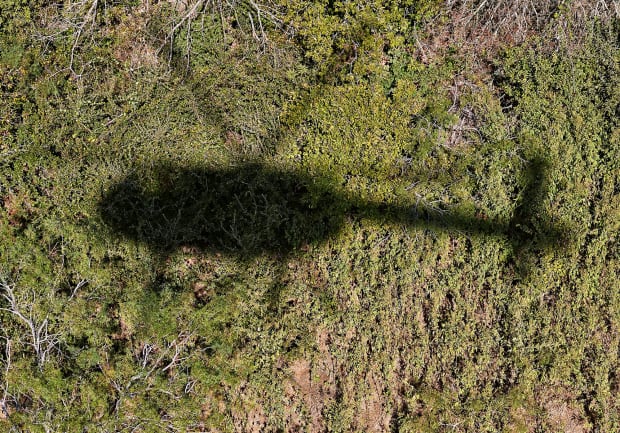
This story appears in the February 2020 issue of Sports Illustrated. To subscribe, click here.


0 comments:
Post a Comment